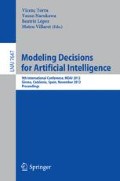Abstract
Active learning has played an important role in many areas because it can reduce human efforts by just selecting most informative instances for training. Nevertheless, active learning is vulnerable in adversarial environments, including intrusion detection or spam filtering. The purpose of this paper was to reveal how active learning can be attacked in such environments. In this paper, three contributions were made: first, we analyzed the sampling vulnerability of active learning; second, we presented a game framework of attack against active learning; third, two sampling attack methods were proposed, including the adding attack and the deleting attack. Experimental results showed that the two proposed sampling attacks degraded sampling efficiency of naive-bayes active learner.
Access this chapter
Tax calculation will be finalised at checkout
Purchases are for personal use only
Preview
Unable to display preview. Download preview PDF.
References
Barreno, M., Nelson, B., Sears, R., Joseph, A.D., Tygar, J.D.: Can machine learning be secure? In: ASIACCS, pp. 16–25 (2006)
Newsome, J., Karp, B., Song, D.: Paragraph: Thwarting Signature Learning by Training Maliciously. In: Zamboni, D., Kruegel, C. (eds.) RAID 2006. LNCS, vol. 4219, pp. 81–105. Springer, Heidelberg (2006)
Lewis, D.D., Gale, W.A.: A sequential algorithm for training text classifiers. In: 17th ACM International Conference on Research and Development in Information Retrieval, pp. 3–12. Springer (1994)
Tong, S., Koller, D.: Support vector machine active learning with applications to text classification. Journal of Machine Learning Research 2, 45–66 (2001)
Campbell, C., Cristianini, N., Smola, A.: Query learning with large margin classifiers. In: Proc. 17th International Conf. on Machine Learning, Madison, pp. 111–118. Morgan Kaufmann (2000)
Cohn, D.A., Ghahramani, Z., Jordan, M.I.: Active learning with statistical models. Journal of Artificial Intelligence Research 4, 129–145 (1996)
Roy, N., McCallum, A.: Toward optimal active learning through sampling estimation of error reduction. In: Proc. 18th International Conf. on Machine Learning, pp. 441–448. Morgan Kaufmann, San Francisco (2001)
Seung, H.S., Opper, M., Sompolinsky, H.: Query by committee. In: Proceedings of the Fifth Workshop on Computational Learning Theory, San Mateo, CA,, pp. 287–294. Morgan Kaufmann (1992)
Freund, Y., Seung, H.S., Shamir, E., Tishby, N.: Selective sampling using the query by committee algorithm. Machine Learning 28, 133–168 (1997)
Long, J., Yin, J., Zhu, E., Zhao, W.: Active learning with misclassification sampling based on committee. International Journal of Uncertainty, Fuzziness and Knowledge-Based Systems 16(suppl.1), 55–70 (2008)
Lee, W., Stolfo, S.J.: A framework for constructing features and models for intrusion detection systems. ACM Trans. Inf. Syst. Secur. 3(4), 227–261 (2000)
Kruegel, C., Tóth, T.: Using Decision Trees to Improve Signature-based Intrusion Detection. In: Vigna, G., Kruegel, C., Jonsson, E. (eds.) RAID 2003. LNCS, vol. 2820, pp. 173–191. Springer, Heidelberg (2003)
Kang, D.-K., Fuller, D., Honavar, V.: Learning Classifiers for Misuse Detection Using a Bag of System Calls Representation. In: Kantor, P., Muresan, G., Roberts, F., Zeng, D.D., Wang, F.-Y., Chen, H., Merkle, R.C. (eds.) ISI 2005. LNCS, vol. 3495, pp. 511–516. Springer, Heidelberg (2005)
Liao, Y.: Machine learning in intrusion detection. PhD thesis, Davis, CA, USA (2005)
Rieck, K.: Machine Learning for Application-Layer Intrusion Detection. PhD thesis, Berlin, Germany (2009)
Liao, Y., Vemuri, V.R.: Use of k-nearest neighbor classifier for intrusion detection. Computers & Security 21(5), 439–448 (2002)
Lazarevic, A., Ertöz, L., Kumar, V., Ozgur, A., Srivastava, J.: A comparative study of anomaly detection schemes in network intrusion detection. In: SDM (2003)
Mahoney, M.V., Chan, P.K.: Learning nonstationary models of normal network traffic for detecting novel attacks. In: KDD, pp. 376–385 (2002)
Chung, S.P., Mok, A.K.: Collaborative intrusion prevention. In: WETICE, pp. 395–400 (2007)
Fogla, P., Lee, W.: Evading network anomaly detection systems: formal reasoning and practical techniques. In: ACM Conference on Computer and Communications Security, pp. 59–68 (2006)
Lowd, D., Meek, C.: Adversarial learning. In: KDD, pp. 641–647 (2005)
Tan, K.M.C., Killourhy, K.S., Maxion, R.A.: Undermining an Anomaly-Based Intrusion Detection System Using Common Exploits. In: Wespi, A., Vigna, G., Deri, L. (eds.) RAID 2002. LNCS, vol. 2516, pp. 54–73. Springer, Heidelberg (2002)
Barreno, M., Nelson, B., Joseph, A.D., Tygar, J.D.: The security of machine learning. Machine Learning 81(2), 121–148 (2010)
Lloyd, S.P.: Least squares quantization in pcm. IEEE Transactions on Information Theory 28(2), 129–136 (1982)
Zhu, X., Goldberg, A.B.: Introduction to Semi-Supervised Learning. Synthesis Lectures on Artificial Intelligence and Machine Learning. Morgan & Claypool Publishers (2009)
Archive, T.U.K.: Kdd cup 1999 data (October 1999)
Author information
Authors and Affiliations
Editor information
Editors and Affiliations
Rights and permissions
Copyright information
© 2012 Springer-Verlag Berlin Heidelberg
About this paper
Cite this paper
Zhao, W., Long, J., Yin, J., Cai, Z., Xia, G. (2012). Sampling Attack against Active Learning in Adversarial Environment. In: Torra, V., Narukawa, Y., López, B., Villaret, M. (eds) Modeling Decisions for Artificial Intelligence. MDAI 2012. Lecture Notes in Computer Science(), vol 7647. Springer, Berlin, Heidelberg. https://doi.org/10.1007/978-3-642-34620-0_21
Download citation
DOI: https://doi.org/10.1007/978-3-642-34620-0_21
Publisher Name: Springer, Berlin, Heidelberg
Print ISBN: 978-3-642-34619-4
Online ISBN: 978-3-642-34620-0
eBook Packages: Computer ScienceComputer Science (R0)

